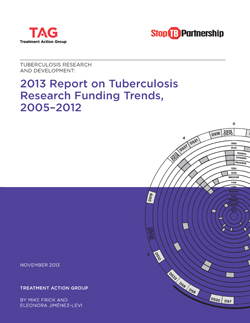2013 Report on Tuberculosis Research Funding Trends, 2005–2012
NOVEMBER 2013
BY Mike Frick and Eleonora Jiménez-Levi
Edited by Mark Harrington
From the Executive Summary
Over the last eight years, Treatment Action Group (TAG) has tracked annual spending on tuberculosis research and development (TB R&D) and compared investments in six areas of research with the corresponding annual funding targets called for by the Stop TB Partnership’s 2011–2015 Global Plan to Stop TB (2011–2015 Global Plan). For the first seven years, TAG observed slow and unsteady increases in funding signaling slow progress toward the new tools needed to end the global TB epidemic. This year, for the first time, TB R&D investors reported a drop in spending that threatens to undermine the tenuous gains made since 2005.
The insufficient year-to-year funding increases observed from 2005 to 2011 have now sputtered and reversed. The 2013 Report on Tuberculosis Research Funding Trends, 2005–2012 shows that funding for TB R&D dropped by $30.4 million in 2012 compared with 2011. With this setback, total spending of $627.4 million on TB R&D in 2012 now sits below the investment levels seen in 2011 and 2010, and pales in comparison with the $2 billion annual funding target outlined in the 2011–2015 Global Plan.
The $30.4 million drop in funding reflects an unprecedented pullback from the private sector, which reduced its investments by 22.1% in 2012 to supply 18% of total TB R&D spending. Some companies, such as Pfizer, withdrew from the TB R&D field entirely, while others, such as Otsuka, decreased their investments in drug discovery programs.
Even more troubling than the $30.4 million decline is that this drop occurred in 2012, before the implementation of sequestration-related funding cuts in the United States, home to many of the world’s leading public-sector TB R&D donors. As in previous years, the public sector provided the greatest share of TB R&D funding in 2012, with 61 percent of the global total. Yet the drop in private-sector spending promises to place greater pressure on public institutions just as they become vulnerable to the shortsighted attacks of fiscal austerity measures in the United States and Europe. Philanthropic support, which remained relatively flat in 2012, with 20 percent of the global total, cannot close a gap created by the twin forces of public-sector budgetary woes and private-sector disinvestment.
From the Pediatric TB Research Supplement
By Erica Lessem and Eleonora Jiménez-Levi
Research is urgently needed for better vaccines, diagnostics, and treatment options to protect children from and cure them of tuberculosis (TB). Funding for TB research and development (R&D) overall is dangerously inadequate—in 2012, TB R&D suffered a $1.4 billion shortfall, according to Treatment Action Group’s (TAG’s) 2013 Report on Tuberculosis Research Funding Trends, 2005–2012. In partnership with the World Health Organization, UNICEF, and others, TAG recently published the Roadmap for Childhood Tuberculosis, which outlines key actions and investments needed to address pediatric TB. The report estimates that R&D projects to provide new tools to prevent, diagnose, and treat TB among children specifically will require $200 million in investments between 2011 and 2015. The portion of TB R&D funding going to pediatrics, and whether this funding is adequate to address knowledge and product gaps, has been unknown. This supplementary report is the first to identify funding amounts for pediatric TB research.

